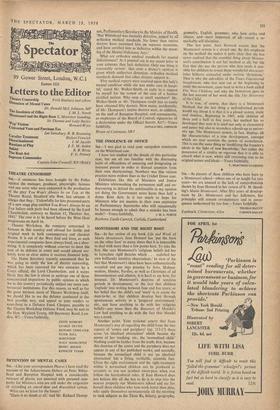MONTESSORI AND THE RIGHT BOOT
SIR,—In her review of my book Life and Work of Maria Montessori, Jean Howard has 'put the boot on the other foot' so many times that it is impossible to deal with more than a few points here. To take the first. She says Montessori's 'religious beliefs led her to formulate rigid theories which . . . stultified her own brilliantly intuitive observations.' In view of the fact that Montessori's ideas have been enthusiastically accepted and put into practice by Jews, Moham- medans, Hindus, Parsees, as well as Christians of all denominations and atheists, it is hard to see how, for instance, Dr. Montessori's doctrine of sensitive periods in development; or the fact that children `explode' into writing between four and five years; or her belief that the child's real 'work' is to create the man-to-be; or that children develop best through spontaneous activity in a 'prepared environment,' etc., can have anything to do with her religious beliefs—any moro than the discovery of Mendel's Law had anything to do with the fact that Mendel was a monk.
Another point. Your reviewer asserts that from Montessori's way of regarding the child from the two aspects of 'centre and periphery' (pp. 213-17) there arose 'an idealised abstraction' which became the centre of her teaching, viz., the 'normalised child.' Nothing could be farther from the truth; first, because this doctrine of the centre and the periphery does not appear in any of her published works; and secondly, because the normalised child is not 'an idealised abstraction' but a living, verifiable, scientific fact. Given the right environment and the right treatment within it normalised children can be produced as certainly as you can produce sweet-peas when you follow the horticultural rules. If Jean Howard does not believe this all she has to do is to step into the nearest properly run Montessori school and sec for herself these children who love work better than play, who apply themselves spontaneously all the morning to such subjects as the Three Rs, history, geography,
geometry, English, grammar; who love order and silence; and—most important of all—reveal a re- markable self-discipline.
One last point. Jean Howard asserts that the Montessori system is a closed one. By this emphasis on the method she makes it quite clear that she has never realised that the essential thing about Montes- sori's contribution is not her method at all, but the fact that she was the perSon who first made it pos- sible for children to reveal those wonderful character- istics hitherto concealed under various 'deviations.' That is why the sub-editor of the Times Educational Supplement, who was sent out at the beginning to study the movement, came back to write a book called The New Children, and why the Dottorcssa gave to the last account of her work the title The Discovery of the Child.
It is true, of course, that there is a Montessori Method; but the last thing a well-informed person would say about it is that it is a closed system, static and timeless. Beginning in 1907, with children of three and a half to five years, her method has so developed that now it is used not only in elementary and junior but also in secondary schools up to univer- sity age. The Montessori system, in fact, displays all the characteristics of a true development, amongst which we may mention the power of assimilation. This is not the same thing as 'modifying the founder's ideals in the light of new knowledge,' but rather the possession of a vitality so vigorous that it is able to absorb what is new, whilst still remaining true to its original nature and ideals.—Yours faithfully,
E. MORTIMER STANDING










































 Previous page
Previous page